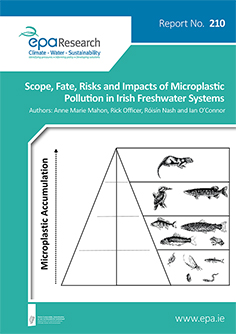Research 210: Scope, Fate, Risks and Impacts of Microplastic Pollution in Irish Freshwater Systems
Authors: Anne Marie Mahon, Rick Officer, Róisín Nash and Ian O’Connor
Summary: Research report 210 on the Scope, Fate, Risks and Impacts of Microplastic Pollution in Irish Freshwater Systems

Identifying Pressures
Principle microplastics pressures were identified as industry, landfill, urban waste water treatment plants (UWWTPs), domestic waste water treatment plants and sewage sludge/biosolids derived from UWWTPs. Manufacturing industries involved in the primary production of polymers, as well as those involved in machining of plastics, were found to emit microplastics to sewer and have high potential as a diffuse source to surface waters via surface run-off. UWWTPs were identified as receptors of the cumulative abundance of microplastics arising from industry, landfill and household waste. Partitioning of microplastics results in the majority of microplastics being incorporated into the sewage sludge, which is mostly land spread in Ireland.
Informing Policy
Potential Implications of microplastic pollution for various legislations were recognised including for the WEEE Directive (2012/19/EU), Packaging Directive (94/62/EC as amended), Waste Framework Directive (2008/98/EC), End-Of-Life Vehicles Directive (2000/53/EC) and the Landfill Directive (1999/31/EEC). In addition, the treatment and use of sewage sludge with MP pollution may have implications for the EU directive (86/278/EEC) which governs the application of sewage sludge to agricultural land. Upon entry to the environment, the potential for a compliance risk was identified for the Habitats Directive (92/43/EEC), the Birds Directive (2009/147/EC), the Water Framework Directive (2000/60/EC), the European Drinking Water Directive (98/83/EC) and the EU Bathing Water Directive (2006/7/EC).
Developing Solutions
This study helped to address a knowledge gap which existed regarding the sources of microplastics from land-based sources. Recommendations were made to move closer to solutions and, in some cases, solutions were offered. Particularly for the manufacturing industry, several recommendations were made with regard to industry processes which could reduce microplastic leakage. This initial study forms a solid basis for further investigations into the sources, fate and transport of microplastics through freshwater systems as well as the possible inclusion of microplastics into monitoring strategies.
https://www.epa.ie/media/epa-2020/publications/research/EPA-RR-210_Cov_20mm[1].jpg